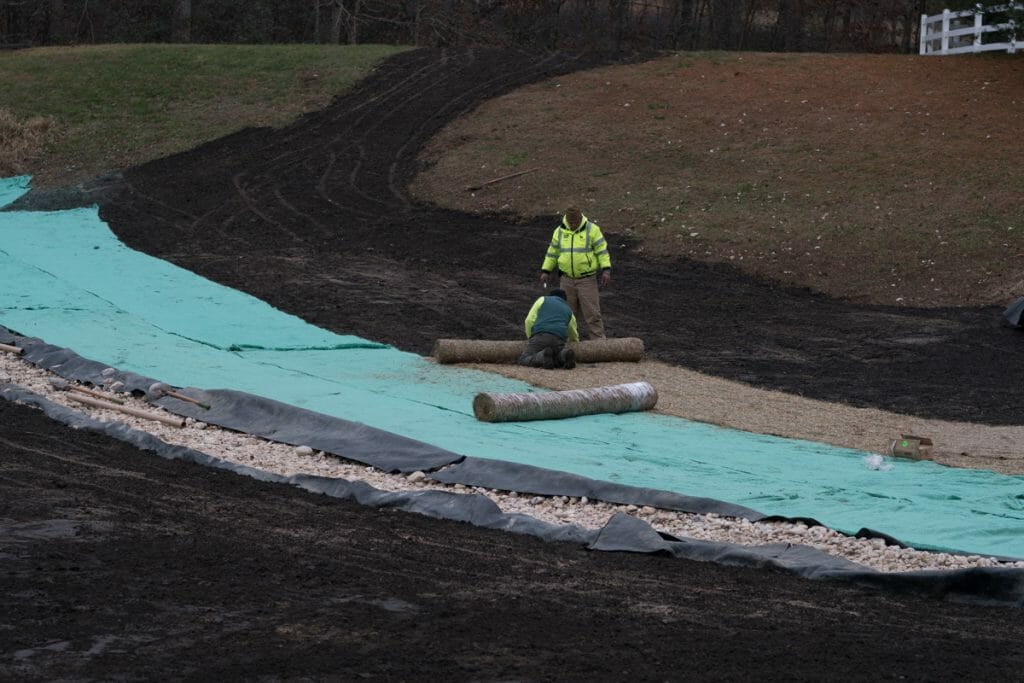Written by Admin and published on https://www.lakesuperiorstreams.org/.
By Design Landscapes was recently tasked with the remediation of an existing stormwater basin for a large adult community. The existing basin had become overgrown with vegetation over years of use along with a build up of organic material that needed to be removed. The new basin was brought up to current water management standards to help reduce the soil erosion impact to the surrounding local environment.
In populated areas such as large developments and shopping centers, the need for diverting water increases. When sewers are not able to handle excess rainfall from inpermerable surfaces like streets and roofs, a common method to manage the water is to use a basin. Stormwater basin are used to collect excess water and release it into the ground at a more natural rate to help prevent local flooding of streams and soil erosion of landscapes.
Bioretention Basins
Bioretention basins are landscaped depressions or shallow basins used to slow and treat on-site stormwater runoff. Stormwater is directed to the basin and then percolates through the system where it is treated by a number of physical, chemical and biological processes. The slowed, cleaned water is allowed to infiltrate native soils or directed to nearby stormwater drains or receiving waters.
These systems normally are composed of seven elements, each element with a different function:
- Grass buffer strip- reduces runoff velocity and removes suspended solids.
- Vegetation –Help remove water through process of evapotranspiration and remove excess nutrients through nutrient cycling.
- Shallow ponding area –provides storage of excess stormwater flows and its subsequent evaporation, also aids in the additional settlement of particulate matter.
- Mulch –an organic layer that encourages micro biological degradation of petroleum-based pollutants, aids in pollutant filtration and reduces soil erosion.
- Engineered soils –to support vegetation growth along with nutrient uptake and provision for water storage. Soils should include some clay to adsorb pollutants such as hydrocarbons, heavy metals and nutrients.
- Sand bed –provide drainage and aeration of planting soil as well as an aid in flushing pollutants.
- Underdrain system –removal of excess treated water to storm drain system or receiving waters.
Bioretention basins are typically associated within small areas of land with residential usage or with parking lots where the islands become visually pleasing stormwater treatment centers.
Excessive stormwater from large storms is normally diverted to stormwater drains once the basin’s ponding area is full.
Applications Bioretention systems can be adapted through minor design adjustments to meet a wide range of climate and geological conditions found in the United States. For colder climate detail refer to State of Minnesota Stormwater Manual-2005, Chapter 12-5: Bioretention [pdf, 1.5 MB]. Additional information on the use of bioretention basins can be found in this manual referring to development of an Operation and Maintenance Check List [pdf, 215 KB], Bioretention Basin concept drawings [pdf, 1.7 MB], cold climate runoff management [pdf, 2.6 MB], guidance for their development in areas of surface bedrock and soils with low infiltration rates [pdf, 3.2 MB] and a list of suitable plants [pdf, 2.2 MB] to use.
Typically bioretention practices are best suited to small sites and highly urbanized spaces. The use of bioretention practices is possible given adaptations to specific site usage conditions are followed, these include:
- Areas where little pervious surface exist, such as parking lots, large buildings or sheds, are ideal candidates for use of bioretention practices such as a bioretention basin. These systems require a relatively large area of land-about five percent of area drained-however, they can be fit into existing parking lot islands and adjoining landscaped areas.
- Areas with highly contaminated runoff, like gas stations and convenience store parking lots, must have the bottom of bioretention basin lined with impermeable liner to prevent egress of contaminated water to nearby stormwater drains, groundwater sources and receiving waters.
- Areas where existing developments are being required to retrofit with stormwater management practices to improve on negative impacts of stormwater will find bioretention a suitable option that can be implemented by modifying present landscape or adding to a parking lot that is being resurfaced. Remember bioretention is best employed for small sites and becomes expensive (land and development costs) when trying to apply to large areas.
- Areas near cold water/trout streams are a good option for inclusion of bioretention basins in a stormwater management plan. Ponding water exists for only short periods and thus not likely to warm-up thereby reducing storm warming.
Additional advantages of using bioretention basins include:
- Aesthetically pleasing if properly designed and maintained.
- Reduces amount of runoff from drainage areas.
- Effective at removal of sediment loads, nutrients, traces of heavy metals, bacteria (possible) and organics found in stormwater. Find out more about these pollutants and their impact on water quality.
- Allows for a flexibility of design layout so able to fit this practice into most landscapes.
- Relatively low maintenance requirement
Original post here https://www.lakesuperiorstreams.org/stormwater/toolkit/bioretention.html.

